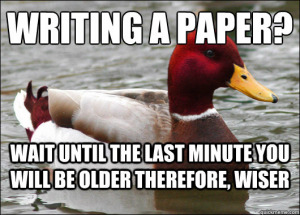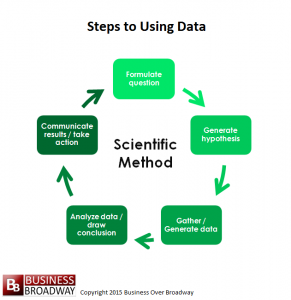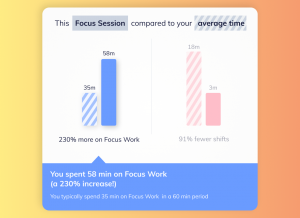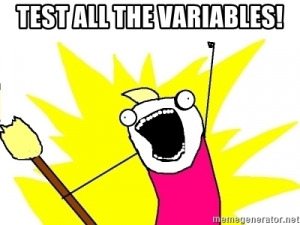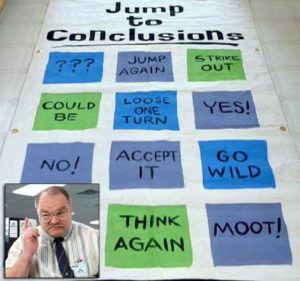As much as I excelled in college, I was always an incorrigible procrastinator — or, as my friends called me, a certified “procrastinatrix.” For the longest time, I joked that my expert skills had landed me a book deal for the orange-and-blue-stamped Complete Idiot’s Guide to Procrastination: a guide that would have been a veritable masterpiece, had I ever gotten around to writing it.
One evening, while evading a research-paper deadline as usual, I transformed the joke into its very own website (which, by the way, you can still find via the Wayback Machine), complete with fabricated reviews. I even Photoshopped a front and back cover, plus hypothetical “excerpts” that were just empty pages — you know, because I’d supposedly put off writing them.
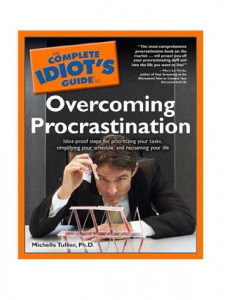 Eventually, I finished my psych paper and submitted it on time. In truth, I rarely procrastinated so severely that I missed an academic deadline completely. Back then and even today, I didn’t procrastinate because I was lazy: I crammed because I’d discovered, over years of honing my methods, that I work best under pressure.
Eventually, I finished my psych paper and submitted it on time. In truth, I rarely procrastinated so severely that I missed an academic deadline completely. Back then and even today, I didn’t procrastinate because I was lazy: I crammed because I’d discovered, over years of honing my methods, that I work best under pressure.
My roommate and fellow psych major was the complete opposite (which is why we never worked on group projects together). His personality was super meticulous and detail-oriented, and when it came to writing papers, he’d go through multiple outlines and drafts. In fact, he’d start on an assignment the same afternoon our professor dished it out. Another major difference? He was unquestionably a morning person, while I focused better at night.
Despite our vastly different approaches, we both thrived as A-students and graduated at the top of our class. It turns out, there wasn’t a right versus a wrong way of getting things done; we simply had different productivity styles. And most likely, no matter what your workday environment looks like or what your chronotype is, you have your own productivity style — and so-called “golden hour” of getting stuff done — that falls somewhere in the middle of these extremes.
So how do you seize that magical window of opportunity and harness it to become the most productive version of yourself? Read on, because we’ve seized our own golden hour to compile a few proactive tips.

Productivity Tips: Follow The Scientific Method
Remember the scientific method? We all learned about it at some point in school, no matter how we approached the task of studying it. Regardless, the process is pretty simple and has a ton of real-world applications outside of your child’s middle-school lab component.
Business Over Broadway, a thought leader at the intersection of business and data science, has adapted the academic version of the scientific method to include the following five steps: 1) make an observation and formulate a question, 2) generate a hypothesis, 3) gather or generate data, 4) analyze the data and draw conclusions, and — most importantly — 5) communicate the results and take action.
Guess what, dear reader? These are the basic, evidence-based steps you can take in your own life to nail down and enhance your productivity once and for all. Let’s get started.
Step 1: Make An Observation And Formulate Your Question
The good news is that you don’t have to start from scratch in your personal experiment: those who have come before you have conducted a surprising amount of foundational research in productivity science. For instance, here’s a recent stat: a 2021 Moneypenny survey found that, overall, the most productive time across all Americans is Monday at 10:54 a.m. Of course, as you might expect, there was ample variation among specific states, with South Dakotans reporting their highest productivity on Fridays at 3:18 p.m. Only Vermont and Utah reported feeling most productive before 9 a.m. (8:30 a.m. and 8:56 a.m., respectively).
The survey also asked respondents how they attempted to increase their productivity throughout the day. Apparently, 50% of respondents reported that getting a good night’s sleep was the most effective method, with other common techniques including taking regular breaks, consuming caffeine, and eating healthy foods.
Want to know how many cups of coffee the average American consumes, stratified by industry? The survey looked at that, too. (Spoiler alert: the leisure, sport, and tourism industries love their extra shot of espresso).
The natural observation here is that, yes, there is so much variation among people when it comes to productivity: when we’re most productive, how we improve our productivity, and even how much we use a specific tool that improves our productivity (don’t ask me how many cups of Death Wish coffee I slurp up in a day). Since science shows evidence of this variation, we know that there’s no one-size-fits-all approach to harnessing our most productive hours; everyone is an experiment of one.
Armed with this information, you can now feel comfortable formulating the question for yourself: “What are my productivity golden hours, and what factors contribute to them?”
Step 2: Generate Your Hypothesis
Now that you have your research question, it’s time to make predictions about your productivity style! Don’t worry about getting too formal with these — just take what you know from research or observation, anecdote, and of course your own intuition.
For example, do you feel cranky in the morning but get a second wind at night? Then one broad hypothesis might be, “My most productive hours are in the evening.” But remember that survey we just mentioned, in which the researchers considered a whole range of factors that may affect productivity. In science, we call those independent variables — not just time of day, but other things at play like how you slept, when you ate at your last meal, how much coffee you drank beforehand, whether you fought with your significant other, or even how many “likes” you received on Instagram (yes, sometimes it is that simple).
This is an experiment centered around you, and you get to be the mad scientist — so have fun with it, and jot down a few predictions! For example, my hypotheses would include that the following factors have a positive effect on my productivity: evening time of day, adequate caffeine consumption, a hearty meal, ample chocolate intake, sufficient sleep the night before, a solid run or workout, comfortable clothes, and of course the alleviation of PMS symptoms.
 Conversely, I’m pretty confident that PMS + hangry stomach + no chocolate in the house would equal the worst productivity ever, no matter what time of day.
Conversely, I’m pretty confident that PMS + hangry stomach + no chocolate in the house would equal the worst productivity ever, no matter what time of day.
Whatever predictions you consider, make sure that you write them down! In the next step, you’ll test your hypothesis by collecting productivity data, so it’s important that you have an idea of what factors you want to explore.
Step 3: Gather Your Data
Welcome to the coolest part of the process: data collection! This is the step where you bring out the nifty technological tools and go for a deep dive into the subconscious habits of your psyche. It’s not often that the experimenter gets to play the role of the research subject, too!
Which tools are we talking about, you might ask? As you may know, self-report studies often have validity problems, so you’ll need to track your productivity data using a more reliable method than your subjective self-assessments. That’s where the technology comes in: yes, there’s an app for that (actually, a few)!
Productivity trackers run in the background of your device, log your activity across programs and websites, and then generate reports on that activity over a specified time period. For instance, you’ll typically see stats including how much time you spent on each website or program overall, the time of day that you accessed and lingered on them, a breakdown of activity into different productivity categories, and comparisons of these metrics over time.
Many trackers even include productivity-boosting or procrastination-busting features, like an alarm that sounds when you start to lose focus and in-app coaching based on daily goals.
Below are just a few of the top productivity trackers on the market, most of which offer a free demo or trial period before you buy. Since you’ll want to collect as many data points as possible to come to a meaningful conclusion, you should track your productivity for at least 30 days to start — that’s long enough to notice some patterns and trends that prevail despite fluctuations or outlier days.
The Tracker Tools
-
RescueTime touts itself as “the only app in the world that can truly measure your focus.” The app analyzes your work style and schedule to assign you a daily focus work goal, measure which programs and websites interrupt your focus, and trigger structured focus sessions to improve your workflow. Free 14-day trial. Download: From $6.50/month
-
Targeted more towards organizations than individual users, Time Doctor syncs with project-management software, generates comprehensive usage reports, and includes features that self-correct employees’ distraction behaviors as well as encourage work-life balance in and out of the office. Free 14-day trial. Download: From $7/month
-
Designed for both single users and larger teams, Toggl offers multiple time-tracking and reporting packages ranging from simple to more sophisticated. In particular, the program provides a versatile tool for freelancers seeking to stay accountable and efficiently turn entries into invoices for their clients. Free 30-day trial. Download: From $0/month for freelancers; $9/user/month for small teams
Now, using a software tracker to estimate your peak productivity after a month is super simple — you just print out a few reports, examine the graphs, and voila! That’s your so-called golden hour, the holy grail of productivity. But remember, your insightful experiment doesn’t stop there. You’re not just interested in how time of day affects your focus — you want to know all the variables you can manipulate to master your time, and that does require some thoughtful reporting.
While you can’t manually record every aspect of your life for the next 30 days — that would definitely not be a productive use of your time — as long as you started with a few carefully constructed hypotheses, you already know which factors are most likely to be at play. For this part of the tracking experience, we recommend becoming best friends with your favorite bullet journal or habit tracker, where you might add at least one short entry per day.
Some daily inspiration 🙂 #bulletjournal #inspiration #handlettering pic.twitter.com/C99bfwika4
— Bullet Journal Porn (@Bullet_Journals) June 6, 2018
I like these physical logbooks because there are so many ways to get creative and personalize them (check out our tips!), but if you’re more of a tech junkie, you can download one of the popular habit tracker apps instead. Did you know: even some of the latest fitness trackers have a built-in way to track daily experiences like your period and your water intake, so take advantage of your watch’s high-tech features, too!
Whether it’s a period symptom, new pregnancy trimester, diet or hydration tweak, out-of-town trip, pleasant or not-so-pleasant family gathering, or any other event you think is significantly helping or hindering your productivity… log it in your journal or tracking app for the next 30 days, while your time-tracking software runs in the background. In the next step comes the big reveal!
Step 4: Analyze The Data And Draw Conclusions
I know I labeled data collection as the fun part of this process, but actually, what could be more fun than pinpointing your results? Don’t think of it as tedious analysis here — I promise, you can skip finding the Z-scores and the p-values, unless you’re a stats nerd like me and genuinely enjoy SPSS syntax (but don’t force me to run any analyses using Excel).
Instead, this is the step where you finally place that last bit of cardboard snuggly into an 1,000-piece jigsaw puzzle, that complex cognitive teaser that’s been tormenting your psyche for weeks. After 30 days of painstaking tracking, both in the background of your MacBook and the forefront of your journal, you’re ready to compare your outputs until all the pieces are satisfyingly aligned.
There’s really no need to get fancy here — just glance at your automatic and manually entered data over the last 30 days and look for meaningful patterns and trends. For example, does RescueTime tell you you’re generally more focused right after lunchtime? That’s a good starting point. But maybe you see a blip in the data last Thursday, when your productivity unexpectedly nosedived around 1 p.m. That’s when you consult your handy food-and-fitness log to narrow down what happened then.
Oh, right, Thursday was that impromptu work meeting you had to squeeze in after a dentist appointment, so you had no time to grab a sandwich. Or maybe that afternoon you had the worst period cramps ever, ugh. Good thing your Garmin app recorded that day of your menstrual cycle, and you kept your symptom journal up to date. So much data to love!
The more data there is, the more there is to love. Get the most from big data in these 7 tips: http://t.co/Vqw8PL3i0m pic.twitter.com/fHfeYKHmNq
— Tableau (@tableau) April 17, 2015
Now that the info is out there, you can spend as much or as little time as you want picking out patterns and organizing the numbers in different ways. The important thing is that you go back to those hypotheses you made at the beginning of the experiment, and use the data to confirm or reject them. You might be surprised at how misguided your predictions were!
Finally, once you’ve examined your results and made relevant connections, you can jump to some evidence-based conclusions about which factors positively and negatively affect your productivity. That is, you can now confidently answer the question you posed precisely 30 days ago: “What are my productivity golden hours, and what factors contribute to them?” (Hint: the answer is likely more complicated than you’d guessed).
Step 5: Communicate Results And Take Action
Time to break out the special-occasion cake knives and dig into the congratulatory red velvet (mm, cream cheese frosting)! You’ve successfully used the scientific method to conduct your very own experiment of one. Hopefully, you feel quite a bit wiser than you did 30 days ago, when you found yourself staring into the productivity abyss.
Don’t stop here — make your experiment count for something. As obvious as it seems, many people skip the step of putting thought into action, science into application. Then, history repeats itself and you neglect the valuable insights you spent the last month trying to achieve.
If your goal was not only to find your most productive hours, but also to seize them to your advantage, the action is simple: increase behaviors that boost your productivity, and reduce behaviors that stifle it. If you tend to be more focused after a high-protein snack, incorporate more of those into your workday diet. If you’re consistently in a slump towards the end of the workday, schedule the more mentally taxing tasks for earlier in the morning. If you write more efficiently within structured interval sessions and well defined breaks, give the 25-minute Pomodoro Technique a go instead of staring at a blank screen indefinitely.
And, of course, if you report to a manager in a traditional office setting, communicate your productivity style so that you can both share a happy, healthy work-life balance.
Now, if you’ll excuse me, I must embark on my next blue-and-orange masterpiece: The Complete Idiot’s Guide to Productivity, and there will even be words on the pages.

What techniques have you successfully used to improve your productivity? Share your tips and tricks in the comments!
For More Articles On Health, Wellness, And Self, Read These:

